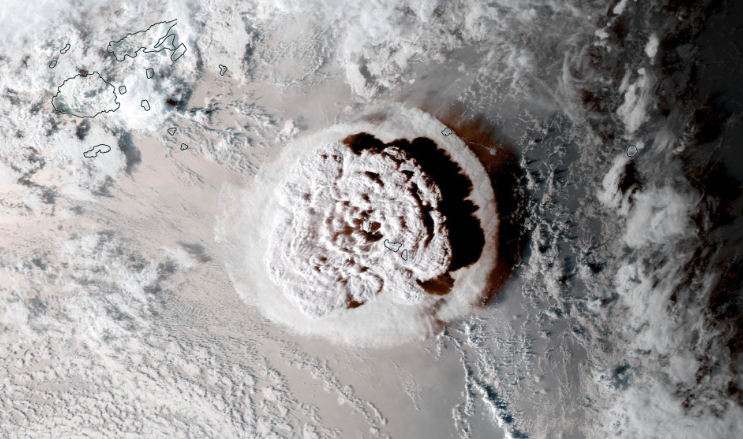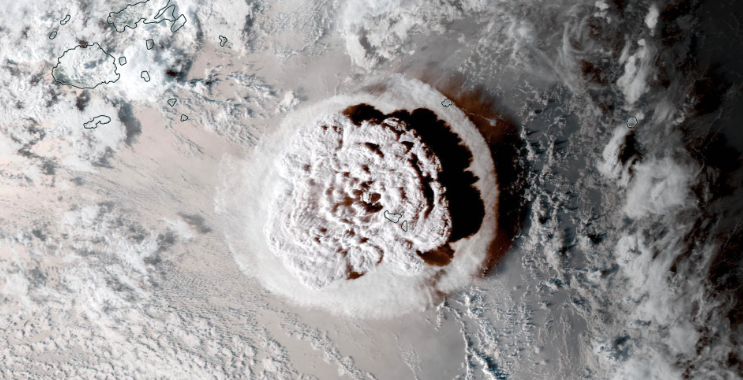
When Tonga’s underwater Hunga Tonga volcano lost its temper during an eruption on Jan. 15, 2022, it spewed globs of magma and blew clouds of ash and water vapor from the ocean, causing intense lightning. This was no ordinary thunderstorm.
Hunga is notorious for its tantrums, but it has outdone itself. That storm now has the most lightning ever recorded on Earth. Hovering ominously over the Pacific Ocean was a volcanic cloud illuminated by concentric rings of lightning that flashed about 192,000 times during the volcano’s 11 hours of activity (that’s about 2,615 flashes per minute). Lightning shot up to 30 km (19 mi) high — another record that beat even cyclones and supercells.
Led by U.S. Geological Survey volcanologist Alexa Van Eaton, a team of researchers scrutinizing observations of the Hunga eruption and subsequent storm found that no one has ever recorded such extreme lightning. “Our findings show that a sufficiently powerful volcanic plume can create its own weather system, sustaining conditions for electrical activity at heights and speeds not previously observed,” said Van Eaton and her team in a recently published study. in Geophysical Research Letters.
Making lightning
Lightning is generated by positively or negatively charged particles formed in turbulent air. For a while, air will act as an insulator and prevent these particles from neutralizing each other. But if enough charge builds up, that can cause a breakdown of that air, allowing electricity to travel so that opposite charges can meet. Their meeting point may be on Earth or where opposing charges have gathered in a thundercloud.
The concentric rings of lightning seen in the upper atmosphere during the Hunga eruption are thought to have been created by high-speed energetic waves known as gravitational waves. As these passed through clouds over the volcano, they caused changes in air pressure and created enough turbulence to generate lightning.
Although Hunga volcano actually started erupting on Dec. 19, 2021, it was most temperamental on Jan. 15, when a volcanic plume exploded about 36 miles (58 km) into the sky. There were two geostationary satellites, NOAA’s GOES-8 (using its Geostationary Lightning Mapper, or GLM) and the Japan Meteorological Agency’s Himawari-8, that tracked the phenomenon as it developed. It was through this data that the researchers identified four phases of the eruption.
Going through phases
During the first phase, the satellites saw the volcanic plume rise and fall, but there was no sign of lightning. The second stage was the most powerful. Magma, water vapor and other volcanic gases shot through the air at incredibly high speeds, bursting past the mesosphere, where the plume previously emerged, and into the stratosphere, where it reached its maximum height. This created a huge umbrella cloud in the stratosphere and a smaller cloud slightly below in the tropopause. The upper cloud is thought to have been as high as 25 miles (40 km). So much mass was thrown into the air that it sent gravitational waves whizzing at speeds in excess of 80 meters per second, creating ripples in the clouds, usually the top cloud, and expanding the lightning rings.
The GLM instrument saw the most lightning as the volcano’s upper umbrella cloud began to move away, revealing its smoking vent. Both the outburst and the lightning calmed down somewhat after that, but increased again in the third phase, and it was not until the fourth phase that the intensity began to decrease.
Unfortunately, as the plume soared beyond 30km (about 19 miles) above sea level, GLM struggled to observe it and the lightning sometimes became undetectable. Van Eaton and her team think this was caused by the lightning flashing too low or too high for the satellite to pick up (it’s more likely it was too low because it should have been visible at a higher altitude).
“This event continues to push the boundaries of our understanding of how explosive volcanism affects the wider Earth system,” Van Eaton said in the study.
Because she and her team found that outbursts can amplify lightning, their discovery will make it easier to assess the risks to aircraft from lightning and ash clouds that can obscure visibility. She plans to study this phenomenon further for more insight. Sometimes special effects in nature can seem more unreal than those in movies.
Geophysical Research Letters, 2023. DOI: https://doi.org/10.1029/2022GL102341 (About DOIs).
Elizabeth Rayne is a creature that writes. Her work has appeared on SYFY WIRE, Space.com, Live Science, Grunge, Den of Geek, and Forbidden Futures. When she’s not writing, she’s transforming, drawing, or cosplaying as a character she’s never heard of before. Follow her on Twitter @quothravenrayne.

